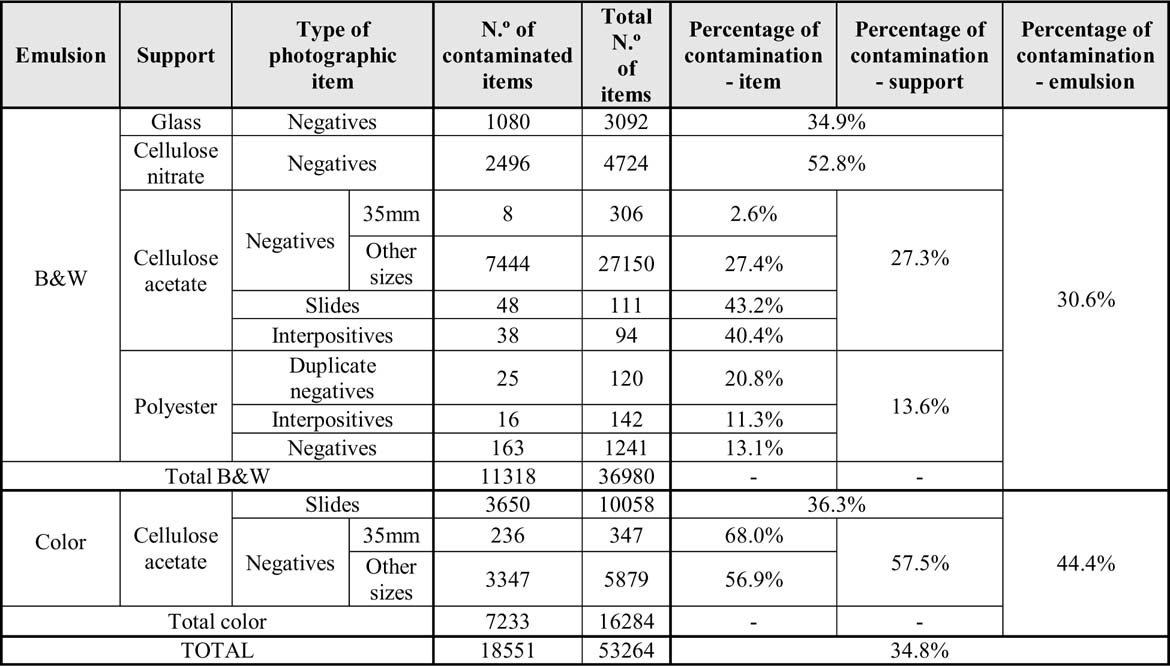
Topics in Photographic Preservation 2007, Volume 12, Article 6 (pp. 19-34)
Presented at the PMG session of the 2006 AIC Annual Meeting in Providence, Rhode Island
Microbial deterioration is a common problem in photographic collections, and has been considered a major cause of deterioration. However, few studies have been carried out on this topic. Indeed, most of the literature is concerned with biodeterioration of archival documents in general, and this includes both micro and macroorganisms. The environmental factors that promote this type of deterioration are well known and most of the published information is about prevention and control. There have been no detailed studies on the interactions between microorganisms, environment and the composition of photographic material.
This study is focused on microbial deterioration of gelatin emulsion photographs, especially related to fungi. It was part of a global study of three collections in Lisbon, Portugal.
The first part is a quantitative study on the microbial contamination of the Horácio Novais collection. The second is about induced contamination experiments of gelatin emulsion photographs. At the end these data will be analyzed taking into account the hypothesis that color materials are more susceptible to microbial deterioration than black and white ones. This hypothesis is based on the observations of several professionals working with photograph collections who report that, at least in plastic base supports (negatives and slides), color materials are frequently more contaminated than the black and white ones.
Photographs; gelatin emulsion; biodeterioration; microbial deterioration; fungi.
Microbial deterioration is a common problem in photographic collections, and has been considered a major cause of deterioration (Bard 1986; Eaton ed. 1985, 37). However, few studies have been carried out on this topic. Most of the literature is concerned with biodeterioration of archival documents in general, and this includes both micro and macroorganisms. The environmental factors that promote this type of deterioration are well known and most of the published information is about prevention and control. There have been no detailed studies on the interactions between microorganisms, environment and the composition of photographic material. It could be noted on the Bronislaw Zysca literature review about fungi isolated from library materials that photographs, and other related audiovisual materials, represent a small proportion of the investigations, and no mention is made to color materials (Zysca 1997). The scale of this problem is unknown.
Microorganisms on photographs appear as spots, blemishes, and in the case of fungi, like small concentric “roots” (hyphae), more or less embedded in the material. They can have colors like white, black, brown, yellow or other (Czerwinska and Kowalik 1979b; Czerwinska and Kowalik 1978a; Montanari 1980). Several morphological characteristics are variable and depend on the growth stage, the nutrients available, the pH of the substrate and other environmental factors. They can show atypical growth forms, and this can create difficulties to detect and evaluate a microbial contamination (Caneva et al. 1991, 36). It is often necessary to use a microscope and it is often necessary to remove samples for examination.
The most biosusceptible photographic materials are the gelatin and the paper, because they are organic and hygroscopic materials. Susceptibility to fungus attack is one of the serious shortcomings of gelatin emulsion films and prints that has never been resolved (Wilhelm 1993, 560). Some external “materials” like dust, grease from fingerprints, and glues are important factors for encouraging microbial development (Eaton ed. 1985, 84; Kodak 2002; Wilhelm 1993, 560). Microorganisms can disturb the visualization of the photographic images simply by their growth, and by producing pigmented metabolites. They can cause damage through the breakdown of the surface material, and by production of enzymes and organic acids. In the case of the gelatin emulsion, enzymes and acids can cause the solubilization and disintegration of the image (Bard 1986; Czerwinska and Kowalik 1979b; Czerwinska and Kowalik 1978a; Gillet and Flieder, 1978; Kodak 2002; Wilhelm 1993, 561). Another reported phenomenon is the appearance of blue or pink stains on B&W films, which is caused by acids that react with the anti-halation layer (Eaton ed. 1985, 84; Pavão 1997, 149). The effect of the metabolites on color materials is more serious because they can affect the dyes (Eaton ed. 1985, 85). There are reports that the silver salts and other compounds in the emulsion of the B&W images do not inhibit sufficiently the growth of fungi and microbes (Czerwinska and Kowalik 1979b; Czerwinska and Kowalik 1978a).
This study is focused on microbial deterioration of gelatin emulsion photographs, especially related to the role played by fungi. Fungi could be considered the principal microbial contaminants of the photographic materials, since they are exclusively heterotrophic and can be active at lower water availabilities than bacteria (Caneva et al. 1991, 56; Kowalik 1980). Fungi were the main isolates found in a study of three Lisbon collections, namely the Bourdin de Macedo collection, the Horácio Novais collection, and the collection of the Portuguese Geographical Society (Lourenço and Sampaio 2005). Part of this study is based on a final project for the C&R graduation approval at the fct/unl, Portugal (Lourenço 2003).
The Horácio Novais collection from the Calouste Gulbenkian art archive has black and white (B&W) glass plate negatives, films, prints as well as color films and prints, with a total about of 93500 photographs. It contains almost all of the work of the Portuguese photographer Horácio Novais, from between 1930s to the 1980s. This collection was kept in the photographer's studio at the Largo Camões, rua da Horta Seca n°7, Lisbon, until its acquisition in 1999 (Ferreira 1991; Lourenço 2001).
The aim of the present study was to investigate the extent of the microbial contamination on gelatin emulsion photographs by giving the example of this collection, and to determine if there are differences in contamination between color and B&W materials. Several Portuguese professionals working with photograph collections report that, at least in plastic base supports (negatives and slides), color materials are frequently more contaminated than the B&W materials, and also that some B&W films were mainly contaminated on the opposite side to the emulsion. Actually, the phenomenon of the contamination of the opposite side of the emulsion was personally verified in a group of large cellulose nitrate negatives that were stored on top of one another, on the original box N.°22, from the Horácio Novais collection (Lourenço 2003).
The data for this quantitative evaluation was researched in a Microsoft Office Access™ database that was created to record information about numbering, cataloguing and inventory of each treated photograph item. The database also included a field for simple conservation diagnosis descriptions. The words and technical expressions used by the several professionals that were involved in this task were standardized. By the time of this research (June 2006) there was available information for about 53264 photograph species (B&W and color films, B&W glass plates, but no prints). The search was made in the conservation description field by the query of the Portuguese word for fungus (fungo), which just allowed identifying the amount of photographs that have fungus contamination, in all the collection and in each type of photograph material or group. The localization and the intensity of the fungal contamination could not be determined from this search. This fact precluded the survey about on which side of the films the contamination was detected.
The data about the quantity and the distribution of contaminated photographs on this collection is shown on Table 1.
Table 1. Quantity and distribution of contaminated photographs in the Horácio Novais collection (data collected in June, 2006)

In the B&W photographs 52.8% of the cellulose nitrate films and 27.3% of the cellulose acetates (negatives, slides and interpositives) were contaminated. A total of 34.9% of the glass plates and 43.2% of the slides were contaminated. The polyester base films were the least contaminated photograph items in the collection, with 13.6% (duplicate negatives, negatives and interpositives) with fungal contamination. It must be pointed out that cellulose acetates have the highest number of items.
On B&W photographs the highest percentages of contamination occurred on cellulose nitrates (52.8%) and on the glass plates (34.9%). This could be related to the fact that these are the oldest photographic materials in this collection, since they belong to the period covering the 1930s to 1950s. It can be assumed that these photographs were submitted to inappropriate storage conditions for a longer period, and because of that there were more chances for fungal development. On the other hand, polyester base films were the least contaminated photograph material. The explanation for this could also be linked to age since polyester base films are the most recent B&W photograph material (the use of polyester in film started in the 1950s). Polyester base films already revealed less biosusceptibility than the cellulose acetates in a previous study (Valentin 1986). In fact, polyester is a synthetic plastic material that does not contain plasticizers (Lavédrine 2003, 21), which are components that have been referred to as substrates for fungal and bacterial colonization on the cellulose plastic materials used in photographic and movie film supports (Czerwinska and Kowalik 1979a; Czerwinska and Kowalik 1978b; Kowalik 1984; Maté et al. 2002; Montanari 1980; Nichols 2003). It is also known that there is a strong link between the degree of substitution of the cellulose acetates (average number of acetyl groups per anhydroglucose unit; can range from 0 in the case of cellulose to 3 for the triacetate) and biodegradability; the lower the degree of substitution the easier the biodegradation (Samios et al. 1997).
The higher contamination percentage of all photographic materials occurred on color acetate negatives (57.5%). Slides had 36.3% of contamination. Color materials represent a small part of this collection. The high levels of contamination, mainly in the color acetate negatives, could be related to a local or specific occurrence. Therefore, it is inappropriate to advance any possible explanations for this at the moment.
In considering the total B&W and total color results of the Horácio Novais collection, 30.6% of the B&W and 44.4% of the color materials had fungal contamination. The difference increases if only the B&W cellulose acetate items (27.3%) and the color cellulose acetate items (44.4%), are considered, which is probably a more correct comparison. So, in the Horácio Novais collection, color materials are 13.8% more affected by fungi than the B&W materials and, in the case of cellulose acetate items, that difference increases to 17.1%. These results seem to indicate a higher susceptibility of color materials to fungal colonization. Nevertheless, a careful global analyses must be done, and particularly consider two relevant issues. Firstly, there are significant differences between B&W and color population sizes. The number of total B&W items is 2.3 times that of the color items, and the number of B&W acetates is 4.4 times that of color acetates. This means that the B&W materials data is more reliable, and that the influence of the hypothetical existence of local contamination phenomena in the results is more reduced. Secondly, there are differences between the age of the color and the B&W materials. The use of B&W materials by Horácio Novais corresponds to the period from the 1930's to the 1970's and color materials to 1970's to the 1980's decade. It could also be assumed that the color materials had a shorter period of inappropriate storage conditions, but despite that, they have a higher contamination percentage.
The aim of this study was to test the hypothesis that the color materials have higher biosusceptibility than B&W materials. The question that comes out from this is what differences between color and B&W photographs could be linked to this? The answer must be the emulsion constitution, and the main difference is that, after processing, B&W images have reduced metallic silver particles and color chromogenic images have organic azomethine dyes. The color chromogenic photographs have yellow, magenta and cyan dyes (the subtractive primary colors) residing in at least three thin layers (Lavédrine 2003, 10; Wilhelm 1993, 15). Unreacted dyeforming couplers could also subsist in emulsions (Wilhelm 1993, 61).
The difference between the image constitution of the B&W and color photographs was the basis for the preparation of the test materials. The goal was to compare the fungal growth in the photographic emulsions with image and non image areas. As a result it was necessary to prepare emulsions with image and non image areas, i.e., with high and low concentration of “image materials”, respectively. In a B&W test material the black areas have a high concentration of reduced silver particles, and the white/transparent areas have only traces or non-existence of reduced silver particles. In a color test material the black areas have a high concentration of all the dyes present in the emulsion, and white/transparent areas do not have dyes (Wilhelm 1993, 15). This was achieved by picturing a target with B&W squares and also by developing completely overexposed and un-exposed photograph test samples (Figure 1).
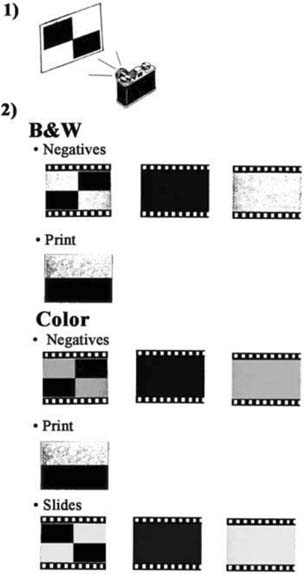
Figure 1: Scheme for the preparation of the photographic test materials: 1) photographing a subject with B&W squares with the test films; 2) obtaining the B&W negatives and prints, and color negatives, prints and slides. The plain black photograms were obtained by developing completely over-exposed film and the plain white photograms were obtained from un-exposed film.
The photographic materials for these tests were not subject to any special selection. Commercially available materials were acquired. After the exposure they were submitted to the normal chemical processing treatments (Table 2). Some preliminary tests were made for the improvement of all the process. For this purpose photographic test materials with other brands, and some older ones also were used. These preliminary tests will be mentioned further, as well as the specifications of the materials used. The 35mm films were cut into single photograms (aprox. 24 × 36mm), and the prints were cut into 40mm squares, in order to fit inside a 90mm plastic Petri dish - the selected “test chamber”. Precautions were taken with the handling and acquisition of the photographic test materials to prevent contamination, but it was not possible to assure sterilization.
Table 2. Photographic materials used for the induced contamination experiments.
Type of photographic materials |
35mm films |
Prints |
B&W (manual processing) |
Negative kodak 5052 tmx - 100 ISO |
ILFORD MGIV multigrade RC DeLuxe; MGD 1M (bright finishing) |
Color (automatic mini-lab processing) |
Negative KODAK Gold 100–6 ISO (C-41 development) |
KODAK Paper (bright finishing) |
|
Slide FUJICHROME 64T Professional Type II Tungsten RTP - 708 Color; 135 ISO (E6 development) |
|
For the tests two fungal strains were selected from the most frequently isolated genera from the study of microbial contaminants from gelatin emulsion photographs belonging to three Lisbon collections: the strain Aspergillus sp. subsec. Versicolores that was isolated from the sample “Bourdin de Macedo n.°21″; the strain Penicillium sp. subsec. Penicillium that was isolated from the sample “Horácio Novais sleeve 4 (99004)” (Lourenço 2003; Lourenço and Sampaio 2005). A 1ml Eppendorf vial for each strain was prepared containing a very high concentration of fresh fungal conidia suspended in a water and detergent solution (0,05% Tween 80). For each 90mm Petri dish that was used as test chambers 15ml of agar (2% W/V) was added to generate high humidity levels for fungal growth promotion. The spore suspension inoculum, the Petri dishes for test chambers, and the agar for humidity generation, were procedures similar to those mentioned in test standards and other studies of induced contamination (astm 1999; McCain and Mirocha 1994; Moriyama et al 1993). Incubation was under laboratory conditions (19–24°C).
In order to minimize curling and condensation, the photographic test materials were placed in the Petri dishes one hour before inoculation. After that time two 1μl drops of the spore suspension were added to the junction of the black and white areas of the films and prints. The photographic test materials with plain images were inoculated once in the centre. All these procedures were done aseptically.
In total there were 18 tests with both strains (Table 3). Each test comprised three replicates or samples (Figure 2). The conidial suspensions of both strains were tested for purity by inoculating plates of a nutrient media (Potato Dextrose Agar), at the start and end of the inoculation of all the photographic test materials.
Table 3. Number and distribution of the induced contamination tests. Each test comprised three replicates or samples.
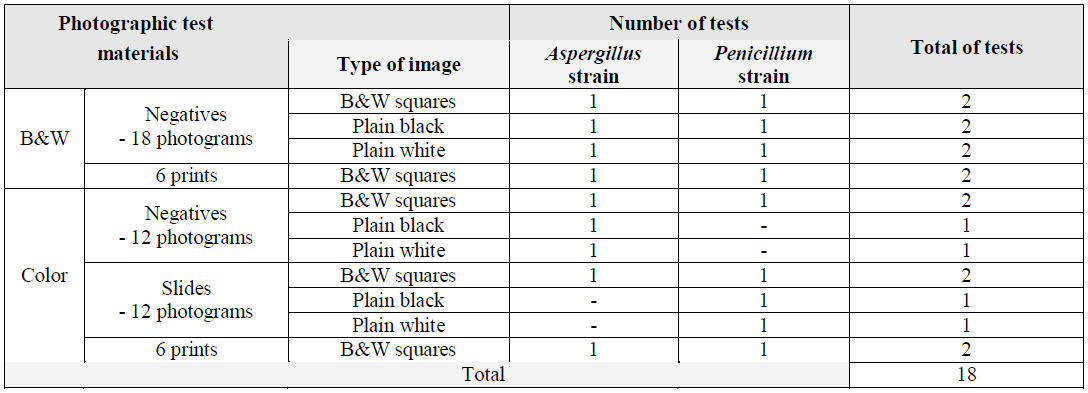
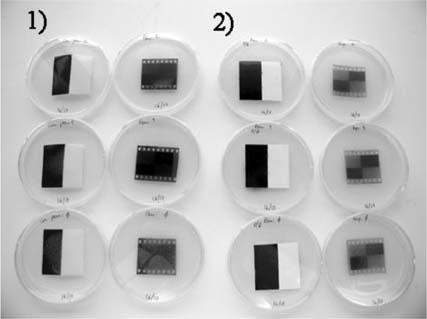
Figure 2: Example of a group of induced contamination tests with three replicates each. 1) color prints and negatives tests; 2) B&W prints and negatives tests.
This experiment was designed as a qualitative examination to determine if there are differences in the fungal growth between image and non-image areas of the selected photographic test materials. The amount of fungal growth was evaluated by measuring the radius of the fungal colony. This simple and direct method is common in taxonomic procedures (Klich 2002, 5; Pitt 2000, 11) and also in mycological studies in general (astm 1998; Klamer et al 2004; Marín et al. 2004; Yonni et al. 2004). In the square images tests that were inoculated at the junction of the B&W areas, the growth symmetry and sporulation intensity were also recorded. The tests were concluded after 20 days of incubation.
In the case of the B&W square negatives, fungal growth was always greater in the white areas (Figure 3). On the plain image negatives tests the area of fungal growth was larger in the white ones (Figure 4), except in one replicate of the black image test with the Penicillium strain, which revealed a similar growth area as the white plain images replicates.
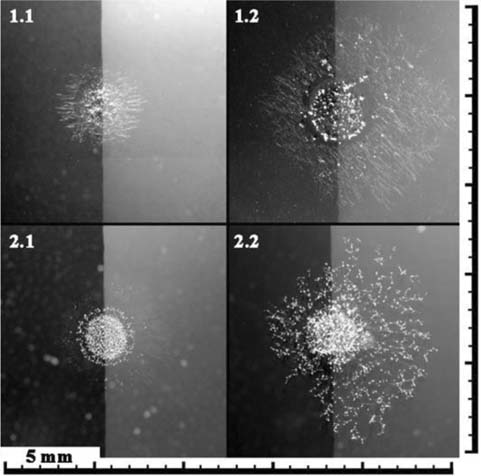
Figure 3: Two examples of fungal growth on B&W negatives with square images. 1.1) Aspergillus strain after 5 days of growth; 1.2) Aspergillus strain after 15 days of growth on the same replicate; 2.1) Penicillium strain after 5 days of growth; 2.2) Penicillium strain after 15 days of growth on the same replicate.
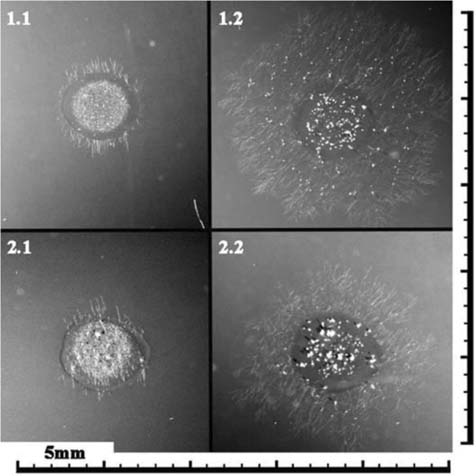
Figure 4: Two examples of Aspergillus growth on B&W plain image negatives. 1.1) plain white image with 5 days of fungal growth; 1.2) the same white image replicate with 15 days of fungal growth; 2.1) plain black image with 5 days of fungal growth; 2.2) the same black image replicate with 15 days of fungal growth.
The B&W prints test was considered null after the fifth day of growth due to contamination problems that disturbed the inoculum's development.
On B&W materials tests, in almost all the replicates that did not have contamination, both Aspergillus and Penicillium strains showed a different growth pattern between black areas (high concentration of reduced silver particles) and white areas (traces of silver particles). There was more extensive growth on the white image areas. The Penicillium strain tests showed slightly more growth compared to Aspergillus strain tests. Sporulation was also more abundant in the Penicillium strain tests.
On color slides with B&W square images there were no differences on fungal growth pattern between the black areas (high concentration of dyes) and white areas (absence of dyes), for both Aspergillus and Penicillium strains (Figure 5). The fungal growth patterns were symmetrical and the growth extension was very similar in all the test replicates. Similar results were obtained with the plain image slides tests. The Penicillium strain tests showed a slightly greater growth extension when compared to Aspergillus strain tests. Sporulation was also more abundant in the Penicillium strain tests.
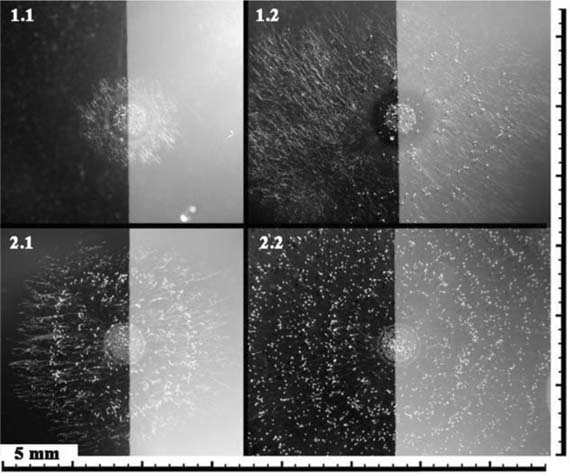
Figure 5: Two examples of color slides with B&W square image tests. 1.1) Aspergillus strain after 5 days of growth; 1.2) Aspergillus strain after 15 days of growth on the same test replicate; 2.1) Penicillium strain after 5 days of growth; 2.2) Penicillium strain after 15 days of growth on the same test replicate.
No fungal growth occurred on color negatives for both the square image test and the plain image tests. The same was found on color prints test.
Photographic materials several years old that were processed at some time before this experiment (2003) were also tested. For convenience the term “old” is used for these materials. The end of 35mm negatives with un-exposed and over-exposed image areas were cut off and used as test samples, as was described previously on point 3.3.3. Older B&W prints samples with un-exposed and over-exposed image areas were also tested. In these tests only the Penicillium strain was used.
On the “old” B&W negatives with square images, in all of the replicates that did not have any visible contamination, there was more extensive growth on the white image areas (Figure 6) while sporulation was more intense on the black areas. A similar result was verified on the “old” B&W resin coated prints test.
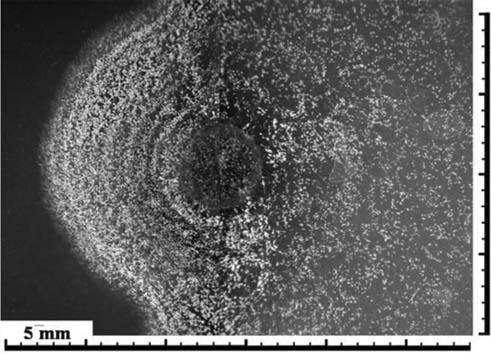
Figure 6: Example of Penicillium growth after 15 days of incubation. “Old” B&W square image negative - kodak 5052 tmx processed in 1998. (Figure composed by two images)
On the “old” color negatives test with square images, in all of the replicates that do not had contamination disturbances, the growth extension and pattern was the same on both sides of the image (Figure 7).
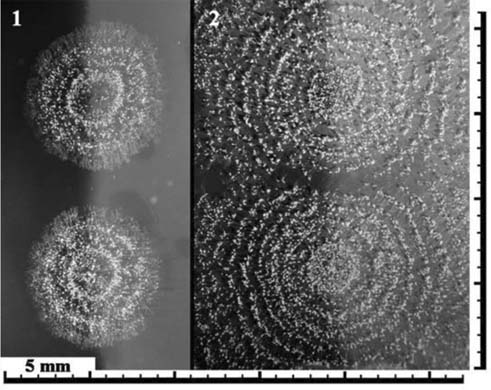
Figure 7: Example of Penicillium growth on an “old” Kodak color negative processed in 2001, after 5 days of incubation (1) and after 15 days of incubation (2).
In the preliminary tests “new” color negative materials, i.e. recently processed, were also used. However, these test materials had two main differences when compared to those mentioned in Table 2: 1) namely the brand was agfa Vista 200; and 2) the square image had three areas with different amounts of dyes and one white area without dyes. In this test fungal growth has occurred, and there were no differences between the areas with dyes and the white areas without dyes (Figure 8).
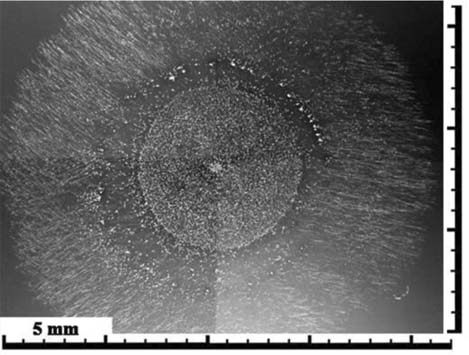
Figure 8: Example of Penicillium growth after 15 days of incubation on a recently processed color negative (agfa Vista 200). Only the upper left square of the negative image is a white area without dyes on the emulsion, the other squares had different amounts of dyes.
On B&W materials all the tests were considered to be valid except the prints test where there were problems with contamination. In all the test replicates with inoculum development, the patterns of fungal growth revealed differences between black areas (high concentrations of reduced silver particles) and white areas (traces or non-existence of silver particles). Growth was more extensive on the white areas of the image than on the black areas. Both Aspergillus and Penicillium strains showed this different growth pattern between image and non-image areas. The Penicillium strain tests showed a slightly greater growth extension and more intense sporulation than the Aspergillus strains. The “old” B&W test materials (negatives and prints) had more intense fungal growth than the recently processed materials. Nevertheless, the same growth pattern with more extensive growth on the white image areas was confirmed.
Fungal growth was affected to some extent by the reduced silver particles present in the B&W images. In most cases sporulation was more intense on the black image areas. This fact could be related to stress conditions that also seem to be linked with the presence of the reduced silver particles. Sporulation is known to be more intense on substrates with mildly inhibiting substances, such as metal particles, as well as under conditions of reduced nutrients and water content.
On color chromogenic materials only the slides tests had fungal development. There were no differences in fungal growth between black areas (high concentrations of dyes) and white areas (low or zero dyes), for both Aspergillus and Penicillium strains. The fungal growth pattern was symmetrical, and the growth extension was very similar between the same test replicates. The Penicillium strain showed a slightly greater growth extension than the Aspergillus strain. Sporulation was also more abundant in the Penicillium strain. No fungal growth occurred on color negatives and color prints tests. However, in the test with recently processed negatives referred to in 3.5.3, with a different brand and image, fungal growth did occur. Thus, the growth pattern with no differences between image and non image areas was similar to what happened in the slide tests. The “old” color negatives test also described on 3.5.3 had a more intense fungal growth when compared to the recently processed materials. Again, the same symmetrical growth, undifferentiated between black and white image areas, was seen. Therefore, it seems that fungal growth was not affected by the dye particles present in the color chromogenic images.
On recent processed color materials, the most extensive growth was found on slides. One brand of negatives had fungal growth, while the other did not. These differences were not expected. These are cellulose acetate films with color chromogenic type of images, with similar structures and processing procedures. No definite explanation for this can be given. However, this could be related to the inhibiting action of possible biocides that may be included in the emulsion. The brand that presented no fungal development probably has more efficient biocide substances. The same explanation could be mentioned for the color prints test. Nevertheless, the discussion about possible inclusion of biocides in photographic emulsions is limited due to the scant information provided by manufacturers of photograph materials. Solutions of formaldehyde (ch2O), a known fungicide and general biocide, have been used as gelatin hardeners in B&W processing (Wilhelm 1993, 534). There are reports that sodium salts of 4-chloro-3-cresol (C7H7C10) have been incorporated in film emulsion (Cappitelli and Sorlini 2005). The available literature refers mainly to the use of products during and/or after processing that have direct or indirect biocide effects (Wilhelm 1993, 561). Usage of the majority of these products was stopped because of high toxicity, high reactivity, low efficiency, and also because of incompatibility with color photographic materials (Czerwinska and Kowalik 1978a; Eaton ed. 1985, 86; Gillet and Flieder 1978; Kodak 2002; Lee 1988; Valentin et al. 1990; Wilhelm 1993, 561).
The interpretation of the most intense fungi growth on the “old” materials, i.e., not recently processed, for both B&W and color materials, could also be related to the effect of biocides incorporated in the emulsion. Generally, the chemical substances used as biocides are reactive and lose their efficiency with time.
On the quantitative evaluation of the Horácio Novais collection, color materials are 13.8% more affected by fungi than the B&W materials and, in the case of cellulose acetate films, that difference increases to 17.1%. Nevertheless there are factors that preclude a direct interpretation of these results, namely the different ages of the photographic materials present in this collection, and the differences in population size of the B&W and color materials that were studied.
In the B&W induced contamination tests, the patterns of fungal growth revealed differences between the black areas (high concentrations of reduced silver particles) and white areas (traces/inexistence of silver particles). There was more extensive growth on the white image areas than on the black areas. In most cases sporulation was more intense on the black image areas. This fact could be related to stress conditions (toxicity) that also seem to be linked to the presence of the reduced silver particles. Fungal growth was affected to some extent by the reduced silver particles present in the B&W images.
In the induced contamination tests on color chromogenic materials where fungal development occurred, the growth pattern was symmetrical with no differences between the black image areas (high concentrations of dyes) and white image areas (traces/inexistent dyes). Fungal growth was not affected by the dye particles present in the color chromogenic images.
No fungal growth occurred in the color prints test, as well as in one brand of color negatives test. This could be related to the inhibiting action of possible biocides that may be included in the emulsion. In the “new” materials, the brand of color negative that had no fungal development probably have more efficient biocides. The same explanation could apply to the color prints test. On both color and B&W “old” materials tests, i.e., processed some years before the experiment, the fungal growth patterns were the same as those seen on the “new” materials, but growth was more intense. The explanation for this could also be related to the effect of biocides in the emulsion. Generally, the chemical substances used as biocides lose their efficiency with time. Nevertheless, the discussion about the biocides used on photographic emulsion fabrication is limited because of the scant information revealed by photographic industries. No definite explanation for the reduced development of fungi in some tests can be made.
The overall appreciation of these results seems to indicate a higher susceptibility of the color chromogenic photographic materials to fungal colonization than the B&W materials. However this hypothesis could not be absolutely confirmed by this study. More profound experiments of induced contamination, with a wider variety of tests and variables control, are needed. Further quantitative and statistical evaluations of other collections could be useful as well. The “feeling” that B&W films were mainly contaminated on the opposite side of the emulsion should also be investigated.
Images equipment: Olympus Camedia C-3030 Zoom digital camera; Leica mz95 stereo microscope; Adobe Photoshop 7.0 software.
The authors would like to thanks to the following Institutions: Calouste Gulbenkian Foundation Art Archive; Lisbon City Council Photographic Archive; Luso-American Foundation. The authors would like to thanks to the following people for their contributes to realize and present this work: Prof. Alan J. L. Phillips; Prof. Filomena Macedo; Prof. Debra Hess Norris; Eng. Luís Pavão; Laura Pol; Filipa Valadares; Sónia Casquiço; Teresa Santos; Margarida Rodrigues; Luisa Casella.
ASTM. 1999. Standard test method for mildew (fungus) resistance for paper and paper and paperboard, D 2020–92. Philadelphia: American Society for Testing and Materials.
ASTM. 1998. Standard guide for developing methodology for evaluating the ability of indoor materials to support microbial growth using static environmental chambers, D 6329–98. Philadelphia: American Society for Testing and Materials.
Bard, C. C. 1986. Biodeterioration of photographs. In Biodeterioration 6: Papers presented the 6th International Biodeterioration Symposium, Washington, D.C., August 1984, Ed. Barry, S., Houghton, D. R., Llewellyn, G. C., and O'Rear, C. E.: cab International: Wallingford, uk. 379–382.
Caneva, G., Nugari, M.P., Salvadori, O. 1991. Biology in the Conservation of Works of Art, iccrom - International Centre for the Study for the Preservation and the Restoration of Cultural Property, Italy.
Cappitelli, F. and Sorlini, C. 2005. From Papyrus to Compact Disc: The Microbial Deterioration of Documentary Heritage, Critical Reviews in Microbiology, 31, Taylor & Francis Inc. 1–10.
Czerwinska, E. and Kowalik, R. 1979a. Microdeterioration of Audiovisual Collections, Part 1. Protection of Audiovisual Records Against Destructive Microflora, Restaurator: International Journal for the Preservation of Library and Archival Material 3(1–2). 63–70.
Czerwinska, E. and Kowalik, R. 1979b. Microdeteroration of Audiovisual Collections, Part 2. Microbial Problems in Photographic Print Collections, Restaurator: International Journal for the Preservation of Library and Archival Material 3(1–2). 70–80.
Czerwinska, E. and Kowalik, R. 1978a. Microbial Problems in Photographic Print Collections, 78/14/14, icom Preprints, 5th triennial meeting, Zagreb.
Czerwinska, E., Kowalik, R. 1978b. Contribution to the protection of audiovisual records against destructive microflora, 78/14/15, I.C.O.M Preprints, 5th Triennial meeting, Zagreb.
Eaton, ed. 1985. Conservation of photographs. Kodak Publication No. F-40, 86. Eastman Kodak Company, Rochester, New York.
Ferreira, A. M. C. 1991. Horácio Novaes, Fotógrafo, História de Arte Contemporânea. Faculdade de Ciěncias Sociais e Humanas/Universidade Nova de Lisboa, Portugal. (Unpublished university report)
Gillet, M. and Flieder, F. 1978. La conservation děs phototypes gelatino-argentiques noir et blanc sur support tri-acetate de cellulose et polyester, 78/14/16, in Comité pour la conservation de 1'icom, 5ème réunion triennale, Zagreb.
Klamer, M., Morsing, E., Husemoen, T. 2004. Fungal growth on different insulation materials exposed to different moisture regimes, International Biodeterioration & Biodegradation 54, Elsevier Science Ltd. 277–282.
Klich, M. A. 2002. Identification of Common Aspergillus Species, 1st Edition, Centraalbureau voor Schimmelcultures, The Netherlands.
Kodak. 2002. Prevention and removal of fungus on film and prints, Kodak customer service pamphlet ae - 22.
Kowalik, R.. 1984. Microbiodeterioration of Library Materials, Part 2, Microbiodecomposition of auxiliary materials, Chapter 5–9, Restaurateur, 6, Copenhagen. 61–115.
Kowalik, R.. 1980. Microbiodeterioration of Library Materials, Part 1, Microbiodecomposition of basic organic library materials, Restaurateur, 4(2). 99–114.
Lavédrine, B. 2003. A Guide to the Preventive Conservation of Photograph Collections, Los Angeles, Guetty Publications.
Lee, M. W. 1988. Prevention and treatment of mold in library collections with an emphasis on tropical climates: a ramp study, prepared for the General Information Programme and unisist, unesco, Paris. http://www.unesco.org/webworld/ramp/html/r8809e/r8809e00.htm#Contents. (accessed 05/09/2005)
Lourenço, M.J.L. 2003. Um estudo sobre deterioração microbiológica de espécies fotográficas com emulsão de gelatina: relatório de projecto para licenciatura em conservação e restauro. Faculdade de Ciěncias e Tecnologia/Universidade Nova de Lisboa, Portugal. (Unpublished C&R graduation project report)
Lourenço, M.J.L. 2001. Tratamento da Colecção Horácio Novais: relatório de estágio para obtenção do bacharelato em conservação e restauro. Faculdade de Ciěncias e Tecnologia/Universidade Nova de Lisboa, Portugal. (Unpublished B. A. final report)
Lourenço, M.J. L. and J.P. Sampaio. 2005. Microbial deterioration of gelatine emulsion photographs: isolation of contaminant microorganisms from three collections. Conservar Património, Issue 2. 13–19.
Marín, S., Ramos, A. J. and Sanchis, V. 2005. Comparison methods for the assessment of growth of food spoilage moulds in solid substrates, International Journal of Food Microbiology 99, Elsevier Science Ltd. 329–341.
Maté, D., Sclocchi, M. C., Ruggiero, D. 2002. I materiali fotografici e il loro deterioramento biológico, Kermes, 47, anno xv, Luglio-Settembre, Itália. 41–53.
McCain, J. W. and Mirocha, C.J. 1994. Screening computer diskettes and other magnetic media for susceptibility to fungal colonization, International Biodeterioration & Biodegradation, 33(3), Elsevier Science Ltd. 255–268.
Montanari, M. 1980. Gli agenti biologici di deterioramento, Bollettino dell'Instituto Centrale per la Patologia del Livro, 36. 163–178.
Moriyama, Y., Kimura, N., Inoue, R., Kawaguchi, A. 1993. Examination of fungal deterioration on plasticized polyvinyl chloride by cryo-scanning electron microscopy, in International Biodeterioration & Biodegradation 31, no. 3, Elsevier Science Ltd. 231–239.
Nichols, D. 2003. Antimicrobial additives in plastics and the European Biocidal Products Directive. http://www.specialchem4polymers.com/2456/eng/article.aspx?id=1084 (accessed 05/21/2005).
Pavão, L.. 1997. Conservação de colecções de fotografia, Dinalivro, Lisboa.
Pitt, J. 2000. A Laboratory Guide to Common Penicillium Species, 3rd Edition, Food Science Australia.
Samios, E., Dart R.K., and Dawkins, J. V. 1997. Preparation, characterization and biodegradation studies on cellulose acetates with varying degrees of substitution, Polymer 38(12), Elsevier Science Ltd. 3045–3054.
Valentin, R. N. 1986. Biodeterioration of library materials disinfection methods and new materials. The Paper Conservator, vol. 10, 40–45.
Valentin, N., Lidstrom, M. Preusser, F. 1990. Microbial control by low oxygen and low relative humidity environment, Studies in Conservation 35. 222–230.
Wilhelm, H. 1993. The Permanence and Care of Color Photographs: Traditional and Digital Color Prints, Color Negatives, Slides, and Motion Pictures, Preservation Publishing Company, usa. http://www.wilhelm-research.com/book_toc.html
Yonni, F., Moreira, M., Fasoli, H., Grande, L. and Cabral, D. 2004. Simple and easy method for the determination of fungal growth and decolourative capacity in solid media, International Biodeterioration & Biodegradation 54, Elsevier Science Ltd. 283–309.
Zysca, B. 1997. Fungi isolated from library materials: a review of the literature. International Biodeterioration & Biodegradation 40(1), Elsevier Science Ltd. 43–51.
Papers presented in Topics in Photographic Preservation, Volume Twelve have not undergone a formal process of peer review.